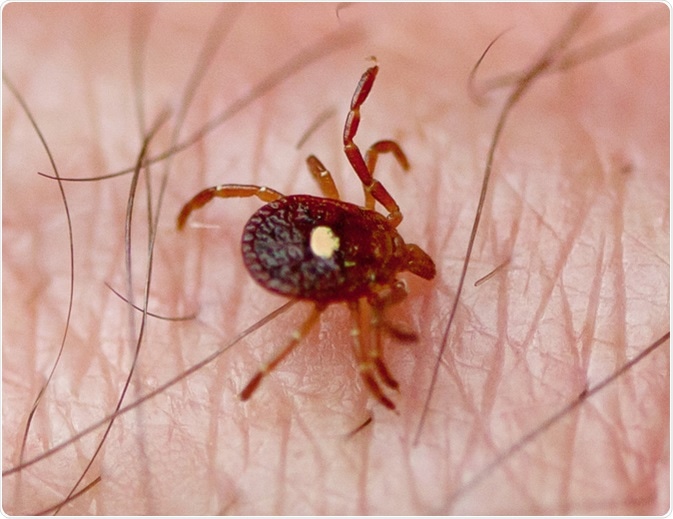Heartland virus represents a newly recognized Phlebovirus that was initially isolated in 2009 from two farmers in northwestern Missouri who were hospitalized with fever accompanied by leukopenia and thrombocytopenia. The causative agent has been found to be carried by the Lone Star tick (Amblyomma americanum), which acts as its primary vector.

Lone Star Tick (Amblyomma americanum). Image Credit: Melinda Fawver / Shutterstock
Detailed phylogenetic analysis revealed that Heartland virus is strikingly similar to severe fever with thrombocytopenia virus, which is also a tick-borne pathogen characteristically found in East Asia. In both cases the vector becomes infected when it feeds on viremic hosts during the larval stage, while transmission to humans is primarily observed during spring and early summer when there is a high chance of contact between humans and abundant, host-seeking nymphs.
Since Heartland virus can sometimes cause disseminated and rapidly fatal infection, swift diagnosis and the implementation of supportive measures is needed. As there is no specific therapy, preventive strategies are recommended in order to minimize contact with the vector.
When is Heartland Virus Infection Suspected?
All individuals with clinically compatible disease (characterized by thrombocytopenia and leukopenia with fever, in the presence of positive laboratory evidence of recent infection with the Heartland virus), must be diagnosed to have this illness.
It must be noted that some cases of the disease present with leukocytosis (or elevated white blood cell count) instead of leukopenia. However, despite the pronounced influence on platelets and white blood cells, anemia is rare.
Elevated liver transaminases have been found to occur in all recorded human cases where data on liver function tests is available. Alanine aminotransferase (ALT) and aspartate aminotransferase (AST) levels typically peak later during the second week of illness. The levels of AST may be up to three times higher than ALT.
Other potentially important laboratory abnormalities (most notably present in severely ill individuals) include elevated bilirubin, low blood levels of sodium, elevated lactate dehydrogenase (LDH), and very high levels of ferritin (an iron storage protein).
When ferritin levels are found to be significantly increased, the possibility of hemophagocytic lymphohistiocytosis (HLH) must be ruled out. One patient with a documented rise in ferritin levels met the diagnostic criteria for HLH in the bone marrow – a hyperinflammatory, life-threatening syndrome characterized by the overproduction of activated immune cells. Another patient with similar findings showed simple hemophagocytosis (i.e. phagocytic clearance of lymphocytes and erythrocytes) in the bone marrow. The presence of such findings should also raise the suspicion of Heartland virus infection.
Validated Diagnostic Tests to Prove the Infection
According to the U.S. Centers for Disease Control and Prevention (CDC), testing for Heartland virus should be considered for all patients who present with an acute febrile illness within the last three months, coupled with at least one epidemiologic criterion (known tick bite, tick found on body, residing in or traveling to endemic areas) and at least one clinical criterion (leukopenia, thrombocytopenia, suspected tick-borne disease that fails to respond to appropriate antibiotics).
Currently available tests for Heartland virus infection include reverse transcriptase polymerase chain reaction (RT-PCR), microsphere-based immunoassay for the detection of IgM and IgG antibodies, as well as plaque reduction neutralization test to measure specific neutralizing antibodies.
For specimens that are collected less than seven days after symptom onset, serum and/or whole blood should be submitted for both RT-PCR and antibody testing. Conversely, if more than seven days have passed after the onset of symptoms, only antibody testing is pursued (unless the patient is immunocompromised).
Treatment and Prevention
At the moment there are no known antiviral treatments available to physicians to treat the Heartland virus infection; therefore the management of acute disease consists primarily of supportive care. Analgesic drugs and antipyretics are used to reduce pain and fever, respectively. More severe illness sometimes necessitates the use of vasopressor drugs, ventilator support, blood products, or even dialysis.
Nonetheless, antibiotics are sometimes given because ehrlichiosis (tick-borne disease caused by rickettsia-like bacterial agents) is often suspected, due to its similar clinical presentation. If there is no clinical improvement within 48 to 72 hours of introducing tetracyclines (which are the drugs of choice in ehrlichiosis), this shows the condition has a different etiology.
In the absence of proper diagnostic and treatment approaches, prevention is the only viable option. Since the virus is transmitted via infected ticks, general preventive measures are advocated. These include the use of insect repellents, avoidance of wooded and bushy areas, wearing long sleeves and long pants, and performing regular tick checks after being outdoors in endemic areas.
Further Reading
Last Updated: Nov 21, 2018